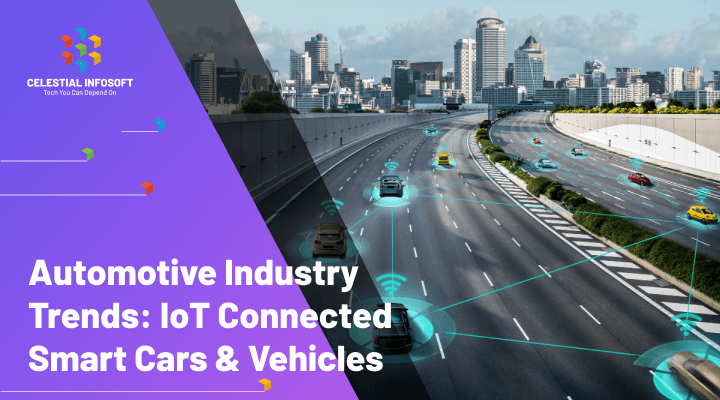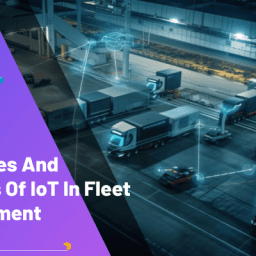
The automotive industry is changing fast because of advances in technology, changing customer tastes, and global environmental concerns. Vehicles are no longer simply mechanical machines; they are transforming into advanced technologies on wheels. One of the most significant advances driving this change is the development of IoT-connected smart automobiles and vehicles. These vehicles take advantage of the Internet of Things (IoT) to provide a seamless, safe, and engaging driving experience with fleet management software From maintenance planning and real-time monitoring to customized information and smart parking solutions, IoT-connected smart cars are changing the way we view and interact with vehicles.
In this blog, we’ll explore the latest trends redefining the automotive industry and Explore how IoT-connected vehicles are steering us toward a smarter, more connected future.
What is the Automotive Industry?
The automotive industry includes all organizations involved in the design, development, production, marketing, and sale of automobiles. This industry is important to the global economy, employing millions of people globally. Technology, customer desires, and environmental concerns have all contributed to considerable developments in the field throughout time. The most recent automotive industry trends are transforming automobiles into advanced technology on wheels, with the Internet of Things (IoT) changing how we drive, particularly with the rise of IoT-connected smart cars and vehicles.
What are the latest Automotive Industry Trends?
1. Electrification
Electric vehicles (EVs) gain popularity as governments around the world restrict emission rules and consumers become more ecologically conscientious. Automakers are making significant investments in electric drivetrains, batteries, and charging infrastructure to provide high-performance, zero-emission vehicles.
2. Autonomous driving
Advances in artificial intelligence (AI), machine learning, and sensor technologies are making self-driving automobiles more conceivable. The goal is to reduce human interference, lowering accidents, and boost mobility for individuals who cannot drive.
3. Connectivity and IoT
Modern vehicles are becoming more linked, using the Internet of Things (IoT) to communicate with other vehicles and infrastructure. This connectivity improves safety, navigation, and the entire user experience by providing real-time data and advanced analytics.
4. Shared mobility
Ride-sharing and car-sharing services are altering the way consumers see vehicle ownership. With urbanization and congestion on the rise, shared mobility offers a handy and cost-effective solution.
5. Online updates
Vehicles, like smartphones, may now receive remote software updates. Over-the-air (OTA) updates allow manufacturers to address issues, add new features, and improve current systems without requiring a dealership visit.
6. Advanced Safety Systems
Safety remains a primary issue, prompting the implementation of Advanced Driver Assistance Systems (ADAS), which include lane-keeping assist, adaptive cruise control, and collision avoidance.
7. 3D Printing and Customization
3D printing streamlines the manufacturing process, reduces waste, and offers customized choices. Automobile manufacturers can quickly prototype and build parts adapted to individual consumer wants.
8. Sustainability and Recycling
With help of smart industrual IOT manufacturers are adopting sustainable materials and encouraging circular economy ideas through recycling and reusing components, reducing the industry’s overall environmental impact.
How are IoT connected smart cars and vehicles transforming the industry?
IoT-connected smart cars and vehicles are leading the automotive revolution. They integrate numerous sensors, software, and real-time data to provide a seamless driving experience. Here’s how they’re changing the industry:
1. Vehicle-to-Everything Communications (V2X)
IoT connected smart cars to connect with other vehicles (V2V), infrastructure (V2I), and pedestrians (V2P). This Vehicle-to-Everything (V2X) connection improves road safety, optimizes traffic flow, and reduces congestion.
2. Predictive Maintenance
Smart automobiles can use IoT sensors to monitor engine performance, fluid levels, and other important information. This predictive maintenance decreases breakdowns, increases vehicle life, and lowers repair costs.
3. Remote Monitoring and Control
IoT-connected smart cars and vehicles enable drivers to monitor their vehicles remotely. A smartphone app allows you to manage fuel levels, check battery charge, and even lock/unlock doors.
4. personalized infotainment
Modern infotainment systems provide personalized recommendations for music, navigation, and even neighboring services based on the user’s interests. IoT-enabled infotainment makes long rides more fun and productive.
5. Over-the-air updates
Smart automobiles with IoT can receive OTA software updates. This keeps your vehicle up to speed with the latest features, bug fixes, and security patches, much like updating a smartphone.
6. Insurance & Fleet Management
Insurance businesses use data from IoT devices to provide usage-based insurance. Real-time tracking, driver behavior analysis, and route optimization all help fleet managers increase efficiency.
7. Enhanced Safety
IoT-connected smart cars & vehicles provide accident warning, blind-spot monitoring, and emergency braking. These devices can inform drivers in real-time, lowering the risk of accidents and ensuring passenger safety.
8. Smart Parking
Finding parking in crowded areas can be difficult. IoT-connected smart cars and automobiles can identify available parking spaces using integrated apps that provide real-time updates, saving both time and effort.
Conclusion
The automobile sector is experiencing a technological revolution, with IoT-connected smart cars and vehicles leading the way. These innovations are altering the driving experience, improving safety, and helping to create a more sustainable future. Whether through electrification, autonomous driving, or predictive maintenance, the industry trends described above point to a more connected and intelligent automotive environment. Accepting these advancements will be important to automakers, technology businesses, and customers as we enter a new era of transportation.





I’m really impressed with your writing skills and also with the structure for your blog. Is that this a paid theme or did you customize it your self? Anyway stay up the excellent quality writing, it’s rare to see a great weblog like this one today!